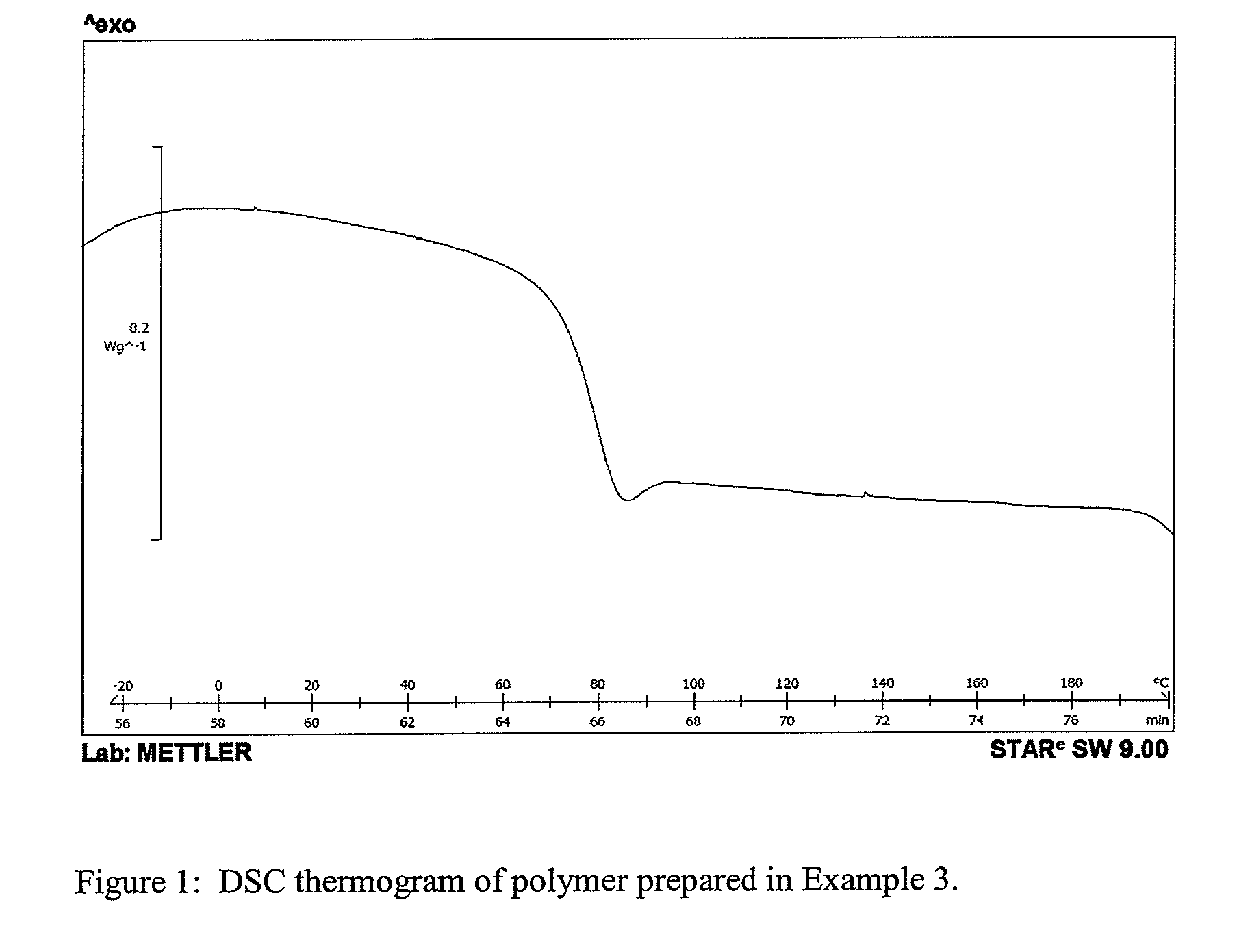High modulus polyurethane and polyurethane/urea compositions
a polyurethane and composition technology, applied in the field of processing polyurethane and polyurethane/urea compositions, can solve the problems of incorporating a second polymer, reducing the elongation rate of the polymer, so as to achieve high modulus, high strength, and high elongation
- Summary
- Abstract
- Description
- Claims
- Application Information
AI Technical Summary
Benefits of technology
Problems solved by technology
Method used
Image
Examples
example 1
[0078]This example illustrates the preparation of a polyurethane series with hard segment weight percentage of 60, 70, 80, 90, and 100% using an 80 / 20 (molar) mixture of IPDI and HDI. The soft segment was LLA-GA (90:10 molar) polyol with a molecular weight of 1033.1 and the chain extender was 1,4-butanediol (BDO).
Step 1: Preparation of Lactic acid-co-Glycolic Acid Polyol (LLA-GA)
[0079]Materials
[0080]Glycolic acid (GA), L-lactic acid (LLA) and 1,4-butanediol (BDO) were used as received. Lactic acid-co-glycolic acid polyol was prepared according to the following procedure.
[0081]Method
[0082]Glycolic acid (142.17 g, 70% in water), 1-lactic acid (1205.6 g, 88% in water) and BDO (75.10 g) were weighed in to a 3 L five-neck round bottom flask. The flask was fitted with a condenser, nitrogen inlet, thermometer, magnetic stirrer bead and the set up was placed in an oil bath. The oil bath was gradually heated to 190° C. The reaction was stopped after 72 h.
[0083]The acid number and hydroxyl nu...
example 2
[0092]This Example illustrates the preparation of polyurethanes by varying the molar ratio of HDI and IPDI while keeping the hard segment weight percentage constant at 60%. The soft segment polyol was P(LLA:GA):90:10 (MW 1033.1) and the chain extender was BDO.
[0093]Materials
[0094]BDO was dried at 70° C. under vacuum (0.1 torr) to reduce moisture content below 200 ppm prior to use in the synthesis. HDI, IPDI and stannous octoate were used as received. Polyol (PLLA:GA, MW 1033.1, prepared according to the method described in Example 1 was dried at 90° C. for 4 hours under vacuum (0.01 torr) prior to use in polymerisation.
[0095]Method
[0096]Four polyurethanes were prepared using the reagents as shown in Table 3. The following procedure was used to prepare sample 2-1 and a similar procedure was used to prepare other samples in the series except, the quantities of reagents used were different as shown in Table 3.
[0097]The method of polymerisation was the same as for Example 1 using the ma...
example 3
[0100]This example illustrates a two-step polymerisation of a 1 kg batch of the polyurethane samples with sample code 1-3 described in Example 1 for evaluation of processability.
[0101]Materials
[0102]BDO was dried at 70° C. under vacuum (0.1 torr) prior to use in the synthesis. HDI, IPDI and stannous octoate were used as received. Polyol (PLLA:GA, MW 1033.1) was dried at under vacuum (0.01 torr) prior to use in polymerisation until less than 200 ppm water.
[0103]Method
[0104]The polyol (200.0 g) and BDO (90.72 g, 40% of required) were accurately weighed in a 2 L glass beaker. The beaker top was covered with aluminum foil and placed in the oven at 70° C. IPDI (482.0 g) and HDI (91.18 g) were weighed in to a separate wet-tared glass beaker and heated to 70° C. The isocyanate mixture was added to the polyol and BDO mixture and stirred manually until the mixture became homogenous. Stannous octoate (0.05 wt % of total mixture) catalyst was added to this while stirring constantly and the tem...
PUM
| Property | Measurement | Unit |
|---|---|---|
| Temperature | aaaaa | aaaaa |
| Temperature | aaaaa | aaaaa |
| Tensile strength | aaaaa | aaaaa |
Abstract
Description
Claims
Application Information
 Login to View More
Login to View More - R&D
- Intellectual Property
- Life Sciences
- Materials
- Tech Scout
- Unparalleled Data Quality
- Higher Quality Content
- 60% Fewer Hallucinations
Browse by: Latest US Patents, China's latest patents, Technical Efficacy Thesaurus, Application Domain, Technology Topic, Popular Technical Reports.
© 2025 PatSnap. All rights reserved.Legal|Privacy policy|Modern Slavery Act Transparency Statement|Sitemap|About US| Contact US: help@patsnap.com



